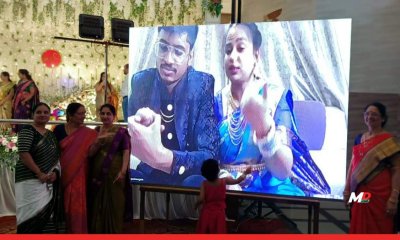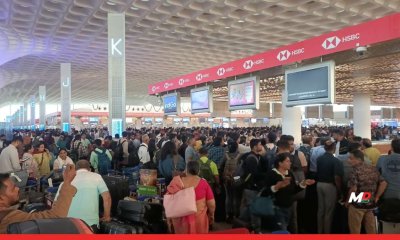Politics
The final showdown: Decoding the decisive 7th phase of India’s 2024 Lok Sabha elections
Published
2 years agoon

As the curtain falls on the world’s largest democratic exercise, the highly anticipated 7th and final phase of the 2024 Lok Sabha elections is upon us. Voters across 8 states and union territories will head to the polls on June 1st, casting their ballots to determine the fate of 904 candidates, including none other than Prime Minister Narendra Modi himself. With a total of 57 seats up for grabs, this last leg of the electoral marathon promises to be a nail-biting affair, one that could very well shape the future of the world’s largest democracy.
The battleground states: A snapshot
The 7th phase of the Lok Sabha elections will see voters from Punjab, Himachal Pradesh, Jharkhand, Odisha, Uttar Pradesh, Bihar, West Bengal, and the union territory of Chandigarh casting their ballots. Each of these regions holds its own unique political landscape, presenting a diverse array of challenges and opportunities for the contesting parties.
Punjab: The Sikh heartland in the spotlight
Punjab, the Sikh-majority state bordering Pakistan, has long been a hotbed of political intrigue and separatist sentiments. This year, the spotlight shines brightly on the Khadoor Sahib constituency, where the entry of Sikh separatist leader Amritpal Singh has sent shockwaves through the security establishment. With the Shiromani Akali Dal (SAD) and Aam Aadmi Party (AAP) also vying for the seat, the battle for Khadoor Sahib promises to be a high-stakes affair with far-reaching implications.
Himachal Pradesh: The Himalayan battleground
In the picturesque state of Himachal Pradesh, the political landscape is equally captivating. Bollywood star-turned-politician Kangana Ranaut of the BJP is challenging the Congress party’s Vikramaditya Singh in the Mandi constituency, a bastion of the Singh political dynasty. Meanwhile, Anurag Thakur, the incumbent BJP minister, is seeking to retain his stronghold of Hamirpur, a family pocket borough.
Jharkhand, Odisha, and Bihar: The decisive troika
Venturing further east, the states of Jharkhand, Odisha, and Bihar present their own unique political tapestries. In Jharkhand, the INDIA alliance led by the Jharkhand Mukti Morcha is locked in a battle for three of the state’s 14 seats. Odisha, governed by the NDA-aligned Biju Janata Dal, will see six of its 21 constituencies up for grabs, while Bihar, where the BJP and its allies hold sway, will witness a fierce contest for eight of the state’s 40 seats.
Uttar Pradesh: The epicenter of the battle
No discussion of the 7th phase would be complete without delving into the political epicenter of Uttar Pradesh, India’s most populous state. Prime Minister Modi himself is seeking a third term from the ancient city of Varanasi, while the Samajwadi Party-backed Ajay Rai poses a formidable challenge. Additionally, the Ghazipur constituency, where Afzal Ansari of the Samajwadi Party is contesting, has garnered significant media attention.
West Bengal: The Trinamool bastion
In the eastern state of West Bengal, the ruling Trinamool Congress (TMC), a member of the INDIA alliance, will be defending its stronghold. All eyes will be on the Diamond Harbour constituency, where Abhishek Banerjee, the influential nephew of Chief Minister Mamata Banerjee, is seeking to cement his political legacy.
Chandigarh: The Union Territory tussle
Rounding out the 7th phase is the union territory of Chandigarh, where the Congress party has fielded former minister Manish Tewari, whose chances have been boosted by the backing of neighboring Punjab’s ruling AAP party. The BJP’s Sanjay Tandon is Tewari’s main challenger in this high-stakes battle.
The Key constituencies: Battlegrounds of the giants
As the nation gears up for the final showdown, several constituencies have emerged as the epicenters of the political tussle. Here’s a closer look at some of the most closely watched battlegrounds:
Varanasi and Ghazipur (Uttar Pradesh)
Prime Minister Narendra Modi’s stronghold of Varanasi, the ancient city along the banks of the Ganges, is once again the center of attention. The BJP has dominated this constituency since the early 1990s, and the party is counting on Modi’s enduring popularity to secure a third term for the prime minister. However, the opposition Congress party, backed by the Samajwadi Party, has fielded Ajay Rai to challenge the incumbent.
In the neighboring Ghazipur constituency, the spotlight is on Afzal Ansari of the Samajwadi Party, who is the brother of the late don-turned-politician Mukhtar Ansari. Paras Nath Rai of the BJP is Ansari’s main rival in this high-stakes contest.
Patna Sahib and Pataliputra (Bihar)
The battle for Bihar’s Patna Sahib and Pataliputra constituencies is shaping up to be a clash of political heavyweights. In Patna Sahib, senior BJP leader and former Union minister Ravi Shankar Prasad is seeking re-election, with the Congress-RJD alliance fielding Anshul Avishek Kushwaha as his challenger.
Meanwhile, in Pataliputra, Misa Bharti, the daughter of RJD founder and former Chief Minister Lalu Yadav, is making another attempt to unseat the BJP’s Ram Kripal Yadav, who has won the seat in the past two elections.
Mandi, Kangra, and Hamirpur (Himachal Pradesh)
The Himalayan state of Himachal Pradesh is witnessing its own high-profile battles. In Mandi, Bollywood actor Kangana Ranaut of the BJP is taking on Vikramaditya Singh of the Congress party, in a constituency long dominated by the Singh political dynasty.
Anurag Thakur, the BJP’s information and broadcasting minister, is seeking a fourth term from the family pocket borough of Hamirpur, where he has a formidable track record of winning by wide margins.
Khadoor Sahib and Jalandhar (Punjab)
The Khadoor Sahib constituency in Punjab has become a focal point of national attention due to the entry of Sikh separatist leader Amritpal Singh, who is contesting the seat from jail. Singh’s Waris Punjab De party backs the Khalistan movement, which seeks a separate Sikh state carved out of Indian Punjab. His main opponents are the Shiromani Akali Dal’s Virsa Singh Valtoha and the AAP’s Laljit Singh Bhullar.
In the Jalandhar constituency, former Chief Minister Charanjit Singh Channi of the Congress party is locked in a three-way battle with the BJP’s Sushil Kumar Rinku and the AAP’s Pawan Kumar Tinu.
Diamond Harbour (West Bengal)
All eyes will be on the Diamond Harbour constituency in West Bengal, where Abhishek Banerjee, the influential nephew of Chief Minister Mamata Banerjee, is contesting on the Trinamool Congress (TMC) ticket. Banerjee is widely seen as the political heir to the chief minister, and his victory would cement the TMC’s dominance in the state.
Chandigarh (Union Territory)
In the union territory of Chandigarh, the Congress party has fielded former minister Manish Tewari, whose chances have been bolstered by the backing of neighboring Punjab’s ruling AAP party. Tewari’s main challenger is the BJP’s Sanjay Tandon, as the incumbent Bollywood actor Kirron Kher, also from the BJP, is not contesting this time.
The voting process: Ensuring a smooth transition
The voting for the 7th phase of the Lok Sabha elections will commence at 7 am local time (1:30 GMT) on June 1st and conclude at 6 pm (12:30 GMT). Voters who are already in the queue by the time the polls close will be allowed to cast their ballots, even if it means keeping the polling stations open for longer.
The political landscape: A shifting paradigm
As the nation prepares to cast its final votes, the political landscape has undergone a significant transformation since the previous Lok Sabha elections in 2019. The opposition Indian National Developmental Inclusive Alliance (INDIA) has centered its campaign on “saving the constitution” from what it alleges are attempts by Modi’s government to undermine fundamental tenets of Indian democracy, such as freedom of the press and the rights of religious minorities. The alliance has also focused on promoting more equitable development in the country.
On the other hand, the governing National Democratic Alliance (NDA), led by Prime Minister Modi’s Bharatiya Janata Party (BJP), is banking on the prime minister’s enduring popularity and the party’s track record of governance. The BJP and its allies won 30 of the 57 seats up for grabs in the 7th phase back in 2019, while the Congress and its then-affiliated parties won 21 seats.
The voting trends: A snapshot
The first six phases of the 2024 Lok Sabha elections have already seen a significant turnout, with the initial phases recording voter participation ranging from 60.5% to 67.3%. This high level of voter engagement underscores the importance that the electorate places on this pivotal exercise in Indian democracy.
The countdown begins: Anticipation and uncertainty
Whether the opposition INDIA alliance can unseat the incumbent NDA government, or if the BJP and its allies can cement their hold on power, remains to be seen. One thing is certain: the 7th phase of the 2024 Lok Sabha elections promises to be a nail-biting affair, with the fate of India’s political landscape hanging in the balance.
You may like
-


📈 Markets Open Strong : Voltas in Focus Amid Recovery Hopes
-


Couple attends own wedding virtually after being stranded by IndiGo
-


IndiGo-ing nowhere: Corporate greed and regulatory failure has grounded a nation
-


The Preliminary Findings of Air India AI171’s Tragic Crash Paint a Disturbing Picture
-


Japan’s Petabit Internet Is Faster Than You can Possibly Imagine
-


Cursed or Collectible? Labubu Dolls Likened to Ancient Demon


